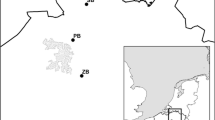Abstract
The appetence responses of the ixodid ticksIxodes rubicundus andRhipicephalus punctatus to various stimuli were quantified under laboratory conditions. A greater percentage ofI. rubicundus generally responded to the different stimuli at lower than at higher temperatures while the converse was usually true forR. punctatus. Radiation heat and shadowing evoked a response in the greatest percentage ofI. rubicundus, whereas CO2 and host odour were responsible for a similar reaction inR. punctatus. A single perturbation of the substrate caused more than 50% ofI. rubicundus to respond while constant perturbation resulted in a progressive decrease in the proportion of ticks reacting. Significantly moreR. punctatus thanI. rubicundus were attracted to a CO2 trap and theR. punctatus were also attracted to the trap over a greater distance. Significantly more older than younger ticks of both species responded to the various stimuli.
Similar content being viewed by others
References
Balashov, Y.S., 1972. Bloodsucking ticks (Ixodoidea): Vectors of diseases of man and animals. Misc. Publ. Entomol. Soc. Am., 8: 376p.
BarnardD.R., 1991. Mechanisms of host-tick contact with special reference toAmblyomma americanum (Acari: Ixodidae) in beef cattle forage areas. J. Med. Entomol., 28: 557–564.
BrowningT.O., 1976. The aggregation of questing ticks,Rhipicephalus pulchellus on grass stems, with observations onR. appendiculatus. Physiol. Entomol., 1: 107–114.
ColborneJ., NorvalR.A.I. and SpickettA.M., 1981. Ecological studies onIxodes (Afrixodes) matopi Spickett, Keirans, Norval-Clifford, 1980 (Acarina: Ixodidae). Onderstepoort J. Vet. Res., 48: 31–35.
ElizarovY.A. and VasewtaA.A., 1976. A distant orientation of blood-sucking ixodid ticks to the host's attractant factors. Parazit. Sb., 10: 136–141.
FourieL.J. and HorakI.G., 1987. Tick-induced paralysis of springbok. S. Afr. J. Wildl. Res., 17: 131–133.
FourieL.J., HorakI.G. and MaraisL., 1988. An undescribedRhipicephalus species associated with field paralysis of Angora goats. J. S. Afr. Vet. Assoc., 59: 47–49.
FourieL.J., HorakI.G. and Van denHeeverJ.J., 1992. The relative host status of rock elephant shrewsElephantulus myurus and Namaqua rock miceAethomys namaquensis for economically important ticks. S. Afr. J. Zool., 27: 108–114.
FourieL.J. and KokO.B., 1992. The role of host behaviour in tick-host interactions: a domestic host-paralysis tick model. Exp. Appl. Acarol., 13: 213–225.
FourieL.J., KokO.B. and VanZylJ.M., 1991. Spatial distribution of the Karoo paralysis tickIxodes rubicundus (Acari: Ixodidae) within a false upper Karoo veld type. Exp. Appl. Acarol., 11: 37–49.
FourieL.J., PetneyT.N., HorakI.G. and DeJagerC., 1989. Seasonal incidence of Karoo paralysis in relation to the infestation density of femaleIxodes rubicundus. Vet. Parasitol., 33; 319–328.
GarciaR., 1962. Carbon dioxide as an attractant for certain ticks (Acarina: Argasidae and Ixodidae). Ann. Entomol. Soc. Am., 55: 605–606.
GinsbergH.S. and EwingC.P., 1989. Comparison of flagging, walking, trapping, and collecting from hosts as sampling methods for Northern Deer Ticks,Ixodes dammini, and Lone-Star Ticks,Amblyomma americanum (Acari: Ixodidae). Exp. Appl. Acarol., 7: 313–322.
GoddardJ., 1992. Ecological studies of adultIxodes scapularis in central Mississippi: questing activity in relation to time of year, vegetation type, and meteorologic conditions. J. Med. Entomol., 29: 501–506.
HairJ.A. and BowmanJ.L., 1986. Behavioural ecology ofAmblyomma americanum (L.), pp. 406–427. In: J.R.Sauer & J.A.Hair (eds.).Morphology, physiology and behavioural biology of ticks. Ellis Horwood, Chichester, England.
HarlanH.J. and FosterW.A., 1990. Micrometeorologic factors affecting field host-seeking activity of adultDermacentor variabilis. J. Med. Entomol., 27: 471–479.
KochH.G. and McNewR.W., 1982. Sampling of lone star ticks (Acari: Ixodidae): Dry ice quantity and capture success. Ann. Entomol. Soc. Am., 75: 579–582.
LaneR.S. and StubbsH.A., 1990. Host-seeking behaviour of adultIxodes pacificus (Acari: Ixodidae) as determined by flagging vegetation. J. Med. Entomol., 27: 282–287.
LeesA.D., 1948. The sensory physiology of the sheep tick,Ixodes ricinus L. J. Exp. Biol., 25: 145–207.
Lees, A.D., 1969. The behaviour and physiology of ticks. In: T.E. Hughes (Chm.)Symposium on physiology in relation to behaviour. Acarol., 6: 397–410.
LoyeJ.E. and LaneR.S., 1988. Questing behaviour ofIxodes pacificus (Acari: Ixodidae) in relation to meteorological and seasonal factors. J. Med. Entomol., 25: 391–398.
NorvalR.A.I., AndrewH.R. and YunkerC.E., 1989. Pheromone-mediation of host-selection in bont ticks (Amblyomma hebraeum Koch). Science 243: 364–365.
RechavY., NorvalR.A.I., TannockJ. and ColborneJ., 1978. Attraction of the tickIxodes neitzi to twigs marked by the klipspringer antelope. Nature 275: 310–311.
Snyman, A., 1993. Vertikale migrasie en gasheeropsporingsgedrag by die Karoo- en Bruinverlammingsbosluis. Unpublished M.Sc. thesis, University of the Orange Free State, pp. 170.
SonenshineD.E., 1991.Biology of ticks. Oxford University Press, New York.
WaladdeS.M. and RiceM.J., 1982. The sensory basis of tick feeding behaviour. In: F.D.Obenchain & R.Galun (eds.),Physiology of Ticks. Pergamon Press, New York, pp. 71–118.
WebbJ.P., 1979. Host-locating behaviour of nymphalOrnithodoros concanensis (Acarina: Argasidae). J. Med. Entomol., 16: 437–447.
Author information
Authors and Affiliations
Rights and permissions
About this article
Cite this article
Fourie, L.J., Snyman, A., Kok, D.J. et al. The appetence behaviour of two South African paralysis-inducing ixodid ticks. Exp Appl Acarol 17, 921–930 (1993). https://doi.org/10.1007/BF02328069
Accepted:
Issue Date:
DOI: https://doi.org/10.1007/BF02328069




